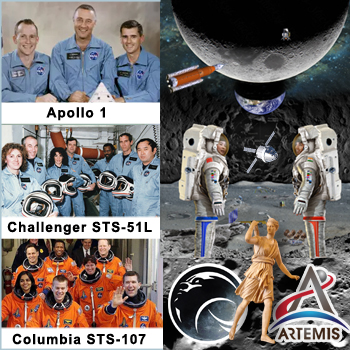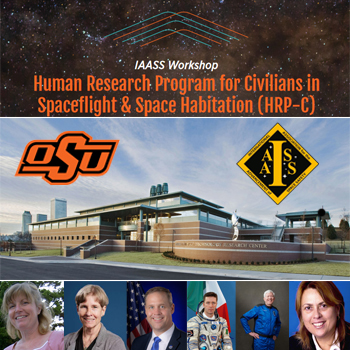Apollo, Challenger, Columbia Astronaut Memorial Week Looks Toward Artemis Missions
In the spirit of remembrance and exploration, this weekend will begin honoring fallen space heroes with the 57th observation Apollo 1 loss of Virgil “Gus” Grissom, Edward H. White and Roger B. Chaffee on January 27; the Challenger STS-51L 38th observation loss of Francis R. “Dick” Scobee, Michael J. Smith, Christa McAuliffe, Ellison S. Onizuka, Judith A. Resnick, Ronald E. McNair, and Gregory B. Jarvis on Jan 28; and the Columbia STS-107 21st observation loss of Richard D. Husband, Laurel Clark, Ilan Ramon, William C. McCool, Michael P. Anderson, David M. Brown and Kalpana Chawla on February 1. Each of their contributions helped advance our ability to reach space and go beyond, a goal undertaken by the re-established USA National Space Council and the Artemis Moon program. Accentuating ‘In Peace for All’ Artemis 3 plans to land the first woman and person of color on the Moon during USA quarter millennial year 2026 while NewSpace commercial enterprise plays a major role in USA return to the Moon under the CLPS program, and international participation in Artemis includes technologies (Orion European Service Module), people (Canada Astronaut Jeremy Hansen on Artemis 2 flight) and policies (33 countries have signed the Artemis Accords). Though rapid development and meeting timelines are critical for mission success, going into space safely, sustainability and inclusively have rightfully been overarching 21st Century principles for the Artemis generation. (Image Credits: NASA, ILOA Hawai’i) |
MONDAY☆ Jan 22 — International Space Station, ~415-km LEO: Expedition 70 seven-members working with four members of Axiom 3, planning for Cygnus cargo arrival next week, preparing for upcoming EVA for Radio Frequency Group (RFG) retrieval. ☆ Jan 22 — Tiangong Space Station, ~390-km LEO: Shenzhou-17 three-member crew welcomes Tianzhou 7 cargo ship – the 12th craft to rendezvous with TSS, and its 7,400 kg of supplies. Highlights… o NewSpace: Hainan Commercial Launch Site Pad 1 in China to support up to 26 LM-8 launches / year while Launch Pad 2, designed to accommodate 19 rockets, continues construction; Impulse Space working toward summer firing of 67,000N methalox Deneb engine for Helios kick stage launching NET 2026; Voyager Space adds Thomas Zurbuchen to advisory board, formalizes Starlab Space LLC with Airbus. ☆ Solar System: Canada-led study of lunar meteorite suggests ancient Moon (4+ bya) was richer in water than previously believed; Phase 1 NASA NIAC-awarded mission concept Sample Return from the Surface of Venus proposes ISRU propellant-powered return capsule delivered via solar airplane; PowerLight Technologies teaming with Blue Origin to develop wireless power technology for Moon under LunA-10 program. ☆ Galaxy: India X-ray space observatory XPoSat on track to commence science operations following XSPECT spectrometer first light of Cassiopeia A; 1.6M solar mass SMBH candidate observed in galaxy GN-z11 with JWST may be oldest yet discovered with origin 400M years after Big Bang; UCF and Cape Canaveral-based biotech company Vaxxinity working to develop therapies to reverse fragility effects associated with long duration human spaceflight. o Global: Austria-based Moon Village Association to propose International Committee on Lunar Operations to UN COPUOS; Oman to begin construction of Etlaq spaceport in Duqm (19.6° N) NET 2025 with launch operations NET 2030; England / Germany study reproduces Fe – Mg interactions on Moon 3.5 bya which led to creation of high-Ti basalts. ● USA: Researchers at Caltech Space Solar Power Project analyzing data from concluded SSPD-1 demo mission; Kurt Vogel to serve as associate administrator for NASA Space Technology Mission Directorate with $1.2B budget; Space Development Agency awards L3Harris ($919M), Lockheed Martin ($890M) and Sierra Space ($740M) to build 54-satellite layer of PWSA constellation. ● Hawai’i: IfA Director Doug Simons estimates UH-Hilo space engineering facility may be completed by end of 2020s dependent on federal funding; NSF-funded Big Astronomy Planetarium Show featuring Gemini North now available for free download; Program to develop space sensors to be established by this year following MoU between UH Mānoa and MDAA of Virginia. |
 |
● = Terrestrial and… o = International terrestrial events
☾ = Moon activity ★ = Space and… ☆ = International space / astro events in Hawaii Standard Time unless noted. Add 10 hours to obtain UT (‘Universal Time’). |
Weekly Planet Watch – Evening Planets: Jupiter (S), Saturn (WSW), Uranus (SW), Neptune (WSW); Morning Planets: Mercury (SE), Venus (SE), Mars (SE).
IAASS Working to Create International Standard for Civilian Health and Safety in Space
|
● Jan 22 — LPI-JSC Center for Lunar Science and Exploration, Online: Intern Applications Due: 2024 Exploration Science Summer Intern Program. ☾ Jan 22 — Moon: 3.9° N of M35 cluster, 17:00. ☆ Jan 22 — Aten Asteroid 2020 YK3: Near-Earth Flyby (0.062 AU) Ongoing… ☾ Sep 6, 2023 – NET Jan 19 — Smart Lander for Investigating Moon (SLIM), Lunar Landing Trajectory: SLIM Moon mission 4-6 month trajectory to soft land east of Shioli crater (13.2°S, 25.2°E) on Moon near side equatorial region. ☆ Sep 6 – NET Mar — X-Ray Imaging and Spectroscopy Mission (XRISM), ~550-km LEO: XRISM undergoing 6 month check out testing phase before start of science operations to study galactic plasma. ● Sep – Feb 15 — Institute for Scientist & Engineer Educators at University of California Observatories, University of Hawaiʻi, Online: Akamai Internship Program; accepting applications from STEM undergrads for 2024 session. ● Jan 19-22 — Kennedy Space Center Visitor Complex, KSC FL: Meet Astronaut Anna Fisher. TUESDAY☆ Jan 23 — CAS Space, Launch Kinetica 1 Flight 3, Jiuquan Satellite Launch Center, China: Kinetica rocket to carry 5 Earth and spatial observation satellites manufactured by MINOSPACE to space. ● Jan 23-24 — International Association for the Advancement of Space Safety (IAASS), Aerospace Corporation, Global Spaceport Alliance, Oklahoma State University, Tulsa OK and Online: Human Research Program for Civilians in Spaceflight and Space Habitation. ☆ Jan 23 — Apollo Asteroid 2021 BL3: Near-Earth Flyby (0.044 AU) WEDNESDAY● Jan 24 — Northrop Grumman, Online: NG 4th Quarter 2023 financial results telecon. ☾ Jan 24 — Moon: 5.1° S of Castor, 04:00; 1.71° S of Pollux, 10:00. |
THURSDAY
● Jan 25 — NASA, Online / Washington DC: Interviews with SpaceX Crew-8 for upcoming mission; starts 13:00 EST.
☾ Jan 25 — Moon: Full Wolf Moon, 07:53; 3.5° NNE of Beehive Cluster, 14:00.
☆ Jan 25 — Apollo Asteroid 2017 BG92: Near-Earth Flyby (0.030 AU)
FRIDAY
★ Jan 26 — Virgin Galactic, Launch Galactic 06 / VSS Unity, Spaceport America NM: Launch planned for suborbital flight carrying 4 paying customers TBC: persons from Texas, California, Austria, and jointly from Ukraine and California.
o Jan 26 — International Astronomical Union, Online: Nomination Submissions Due: Recognizing Champions of Gender Equality in Astronomy.
☆ Jan 26 — Aten Asteroid 2011 CQ1: Near-Earth Flyby (0.028 AU)
SATURDAY
☆ Jan 27 — Rocket Lab, Launch Electron / Skylark Satellites, Launch Complex 1B, Mahia Peninsula, New Zealand: Electron rocket to carry Skylark satellite constellation for Space Situational Awareness services on “Four Of A Kind” (NorthStar 1) mission.
● Jan 27 — Apollo 1 57th Observation, Nationwide USA: Increasing space awareness and education, remembrances and events honor three Apollo 1 crew members lost during a launch pad test: Command Pilot Virgil “Gus” Grissom, Senior Pilot Edward H. White and Pilot Roger B. Chaffee.
● Jan 27 — Rocket Lab, Online: Rocket Lab 4th Quarter 2023 financial results conference.
☾ Jan 27 — Moon: 3.3° NNE of Regulus, 11:00.
☆ Jan 27 — Mercury: 0.24° N of Mars, 07:00.
SUNDAY
● Jan 28 — Challenger STS-51L 38th Observation, Nationwide USA: Educational and ceremonial events held worldwide to advance space technology / education and honor 7 crew members killed in Shuttle accident 28 January 1986: Commander Francis R. “Dick” Scobee, Pilot Michael J. Smith, Astronaut Christa McAuliffe (the 1st ‘Teacher in Space’), Mission Specialists Ellison S. Onizuka, Judith A. Resnick and Ronald E. McNair, along with Payload Specialist Gregory B. Jarvis.
● Jan 28 – Feb 1 — American Meteorological Society, Baltimore MD and Online: AMS 104th Annual Meeting.

